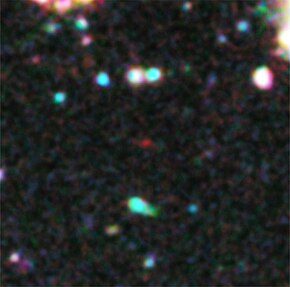

 03h32m39.54s, −27° 46′ 28.4″
03h32m39.54s, −27° 46′ 28.4″| UDFj-39546284 | |
|---|---|

Hubble Space Telescope image of UDFj-39546284 (seen as a reddish spot in the center of the image)
| |
| Observation data (J2000 epoch) | |
| Constellation | Fornax |
| Right ascension | 03h32m 39.54s[1] |
| Declination | −27° 46′ 28.5″[1] |
| Redshift | 11.58+0.05 −0.05[2] [3][4] |
| Apparent magnitude (V) | V fainter than 30.1[5] H160 = 28.92 ± 0.18[5] J125 – H160 >2[5] |
| Other designations | |
| [MDB2013] UDF12-3954-6285, JADES-GS-z11-0 | |
UDFj-39546284 is a high-redshift Lyman-break galaxy discovered by the Hubble Space Telescopeininfrared Hubble Ultra-Deep Field (HUDF) observations in 2009. The object, located in the Fornax constellation, was identified by G. Illingworth (UC Santa Cruz), R. Bouwens (UC Santa Cruz and Leiden University) and the HUDF09 Team during 2009 and 2010.[6][7] It was reported with a redshift of z~10 using Hubble and Spitzer Space Telescope photometric data,[3] with later reports in 2012 suggesting a possibly higher redshift of z = 11.9[8][3] Although doubts were raised that this galaxy could instead be a low-redshift interloper with extreme spectral emission lines producing the appearance of a very high redshift source,[4][3] later spectroscopic observations by the James Webb Space Telescope's NIRSpec instrument in 2022 confirmed the galaxy's high redshift to a spectroscopically confirmed estimate of z = 11.58.[2]
| Preceded by | Most distant astronomical object known 2011 — 2012 |
Succeeded by |
| Preceded by | Most distant astronomical object known 2012 |
Succeeded by |
| Preceded by | Most distant galaxy known 2011 — 2012 |
Succeeded by |
| Preceded by | Most distant galaxy known 2012 |
Succeeded by |
|
| |||||||||||
|---|---|---|---|---|---|---|---|---|---|---|---|
| |||||||||||
| Stars |
| ||||||||||
| |||||||||||
| |||||||||||
| |||||||||||
| Galaxies |
| ||||||||||
| |||||||||||
| |||||||||||
|
2011 in space
| ||
|---|---|---|
2012 » | ||
| Space probe launches |
| |
| Selected NEOs |
| |
| Exoplanets |
| |
| Discoveries |
| |
| Novae |
| |
| Comets |
| |
| Space exploration |
| |
| ||